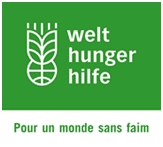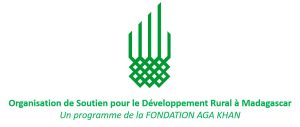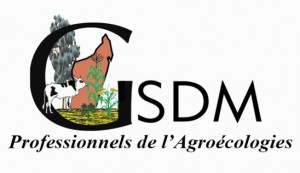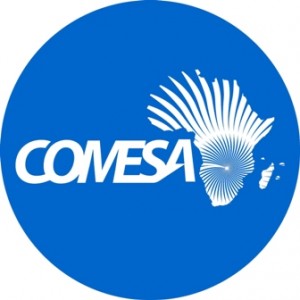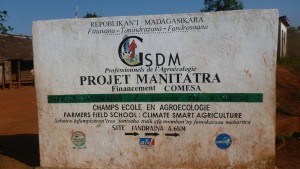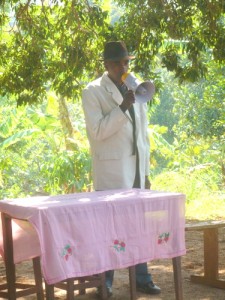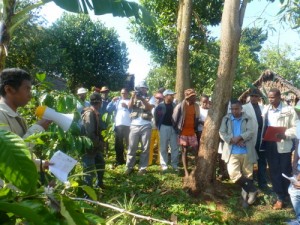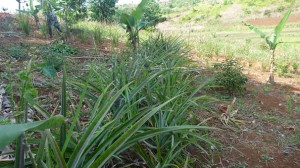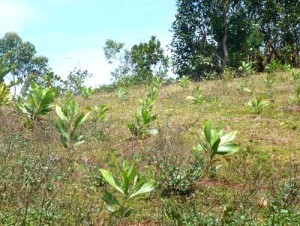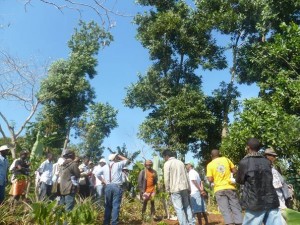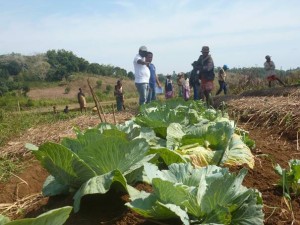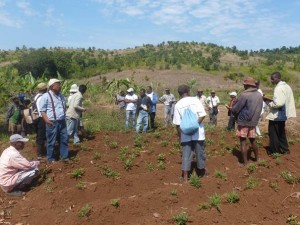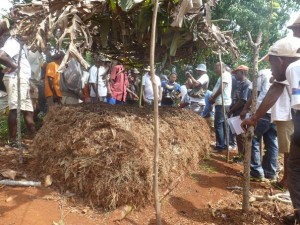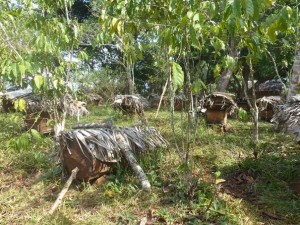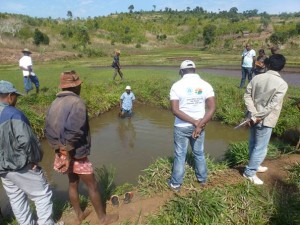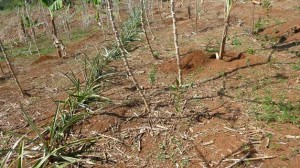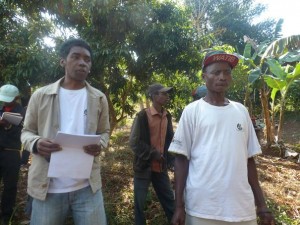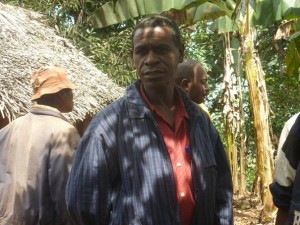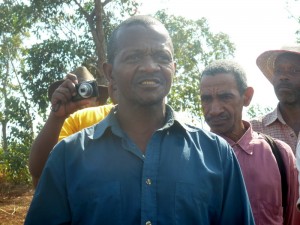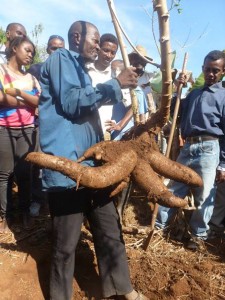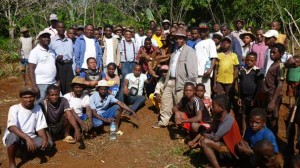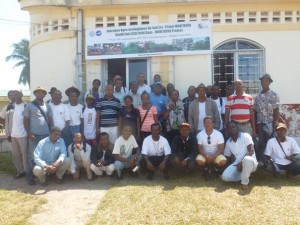Climate Smart Agriculture for food self-sufficiency and protection of natural resources in the South East region of Madagascar
Within the framework of the MANITATRA project implementation on COMESA funding which consists in scaling up the dissemination of agro ecological techniques and /or Climate Smart Agriculture[1] in the Middle West and South East regions of Madagascar, a field day dedicated to Climate Smart Agriculture was planned in each intervention area. The Field Day in the Middle West was held in March 2015 and was a real success:
https://www.youtube.com/watch?v=Pn8fn_M7RIc
https://www.youtube.com/watch?v=AjEr4GEQwa0
In the South East region, the Field Day took place on Thursday, September 17, (field trip), followed by a wrap-up meeting at Impitiny Farafangana on Friday, September 18, 2015 in the morning. The Field Day was honoured by the presence of local authorities, notably the Head of the Region’s representative, the First Assistant to the prefecture, The Regional Directorate of Agriculture (DRDA), some elected authorities (rural mayors..), the PDS (Mayor) of the of Farafangana city and one Representative from the Livestock Regional Directorate. The development actors involved in the region were also responding to GSDM’s invitation, notably the Regional Office for Nutrition (ORN), FAO, DRDA, the Ag Service Centers (CSAs), the German Development NGO WHH… and last but not least, the lead farmers, simple farmers adopting GSDM techniques, nursery people and the local press.
The objective in organizing that day was to raise the local authorities and the local development actors’awareness on the impacts of the activities carried out by GSDM in the South East region through the Manitatra project. The idea is to present the realties on site and draw the participants’attention so that they acknowledge that Agroecology and Climate Smart Agriculture are alternatives to address the stakes of climate change challenges ( natural resources and soil destruction) , and food insecurity and raise debates around sustainable Agriculture in this region which is one of the poorest in Madagascar.
After the series of local authorities’speeches and GSDM Executive Director’s address, the Field Day was declared open by the Representative of the Atsimo Atsinanana Head of Region on the site of Iandraina.
This first day was dedicated to visits to several sites followed by exchanges, discussions and farmers’testimonies. The topics were particularly selected by GSDM according to the realties on site related to the actions undertaken by Manitatra project and the project impacts on the direct and indirect beneficiaries and particularly women who are among the project priorities.
Among the topics, the majority of best practices proposed by the Manitatra project could be visited in the field notably permanent soil cover (Arachis under coffee/clove tree), the use of cover plants (association and rotation : Stylosanthes/Brachiaria/Mucuna), hedgerows and reforestation (Acacia mangium), agroforestry, techniques of basket compost and composting, rice intensification techniques (SRI/SRA), market gardening, the new varieties of orange-flesh sweet potatoes, the use of anti-erosive strips (pine apple), apiculture, pisciculture and improved cowshed as well as farm manure and composting.
During the visits, the participants’ reactivity was quite impressive. The lead farmers and nursery people did not hesitate to talk about their everyday lives in their testimonies. « We started from scratch and after we had adopted Climate Smart Agriculture, we could see our lives developing in the right direction: our plots fertility is regenerated, our harvests become more and more profitable and our children have enough to eat». However, the project beneficiaries showed their concern with regard to GSDM withdrawal and the possible follow-up of Manitatra project. « We are not entirely autonomous in our practices and we would still wish, if possible, some support and technical guidance from the project technicians ».
Moreover, the local authorities were impressed by Manitatra project’s achievements in less than one year’s activity, especially the impacts on the farmers ‘income. GSDM made it clear that Manitatra project’s major objective is to scale up the achievements of previous projects, in particular those of BVPI-SEHP[2]project. The high adaptation of the legume tree Acacia mangium on a very poor land led to an interesting reflection with regard to the possibility of regenerating forests which are beginning to disappear in this region of the South East. The improved cowshed (with compost) was also subject to a big discussion, notably the taboos among Zafisoros tribes prohibiting the construction of a roofed cowshed for zebus. Although this taboo is starting to disappear, a massive awareness raising has to be carried out according to GSDM Executive Director to eradicate these taboos which are major obstacles to the agricultural sector development in the region. The Brachiaria humidicola ability to take over Imperata sp. (tenona) on the degraded lands of the Farmers Field School (FFS) in the site of Iandraina was a success story on this site; moreover, this brachiaria is also used as biomass for basket compost.
With regard to the Manitatra project possible withdrawal, the local development actors joined the Representative of the Head of the Region statement, e.g.: «Projects are not eternal. When they are present, you must take the opportunity to get as much knowledge as possible. And when the project has to withdraw, you will be untroubled as you are autonomous. Even better, you can share your experience and knowledge to your peers in your turn. ».
At the end of the Field Day, the participants were taken to see the plot of a farmer adopting basket compost with anti-erosive cordons of pine apples, a model plot that was replicated by his neighbours. All were impressed by the result of the harvest of a single cassava grown on basket compost from the previous year, which yield many tubers of approximately 20 kg in total from a single plant. Thus, the field trip of the Climate Smart Agriculture day in the South East was closed. GSDM was grateful to the participants who also thanked GSGM in return.
The Wrap-up workshop
The wrap-up workshop of the Climate Smart Agriclture day in the South East took place on Friday September 18, 2015 in the Beaucamps Room at Imptitiny Farafangana, always with the presence of the local authorities, local development actors, lead farmers, nursery people and local press. The major objectives of the workshop are (i) to show MANITATRA project achievements by presenting the progress report of the project in the two intervention areas, (ii) the main problems encountered, (iii) to promote exchanges of experiences and debates to come up with better resolutions.
The workshop was opened by the welcome address of the Urban Commune Mayor of Farafangana (PDS) followed by GSDM Executive Director’s speech and the Representative of the South East Region Head’s address. After the series of addresses, four presentations were made by GSDM team on the progress report of the project, and the researcher from FIFAMANOR on the new varieties of sweet potatoes.
The two area supervisors of the project presented the progress report in their respective areas. Then, the consultant trainer presented a brief overview of the trainings provided and exchange visits organized in the field school of Iandraina site. The researcher of FIFAMANOR shared the necessary information on the new varieties of sweet potatoes, their specificities and advantages.
After the series of presentations, debates and discussions were open to all the participants. The questions on the achievements and impacts of the project were discussed, in particular the availability of sweet potato cuttings and Stylosanthes seed as well as the appropriate equipment to control it, the techniques of basket compost and composting, on reforestation and the nursery people who may work as free-lance service providers in case of withdrawal of the project and its prospects.
To address all these issues, the participants were heard according to their respective responsibilities. The lead farmers spoke about the efficiency of the “farmer to farmer” dissemination strategy. The nursery people expressed their wish to work in collaboration with the local development actors and at the same time raised the issue of the sweet potato cuttings which are not sufficient for mass disseminations. The local development actors encouraged the farmers to continue their effort and try not to rely too much on projects. In this respect, the Head of the region Representative, the first Assistant to the prefecture, and the DRDA Director highlighted that thanks to the support from the government, projects such as GSDM Manitatra project could achieve such goals. As far as the Agriculture sector is concerned, the government takes part in the procedures for implementing these projects via the Ministry of Agriculture, the central authority supported by DRDA, the decentralized authority.
Finally, the Director of DRDA officially closed the workshop by stressing that from now on, Climate Smart Agriculture shall be part of the priorities of the Ministry of Agriculture « Ensure a good management of the soil resources, produce more while protecting natural resources ». He also wanted to congratulate GSDM and encourage the lead farmers and nursery people for their work. « It’s for your own profit and for the future of your children that projects make efforts to pass good farming practices on, so be worthy of it, especially make the most of it to improve your daily life and think of your neighbours by instilling in them the good practices for the sustainable development, that is progress ». Last, he brought up the issue of the possibility of a collaboration between DRDA and the service providers under the funding of the regional Fund for Agricultural Development (FRDA).
[1]Climate Smart Agriculture
[2] BVPI-SEHP : projet Bassin Versant Périmètres Irrigués Sud Est Hauts Plateaux (AFD financing)
Pour plus d’informations, veuillez contacter le GSDM
Antananarivo, le 12 octobre 2015
Mireille RAZAKA, Responsable communication GSDM




